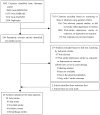Depression and risk of stroke morbidity and mortality: a meta-analysis and systematic review
- PMID: 21934057
- PMCID: PMC3242806
- DOI: 10.1001/jama.2011.1282
Depression and risk of stroke morbidity and mortality: a meta-analysis and systematic review
Erratum in
- JAMA. 2011 Dec 21;306(23):2565
Abstract
Context: Several studies have suggested that depression is associated with an increased risk of stroke; however, the results are inconsistent.
Objective: To conduct a systematic review and meta-analysis of prospective studies assessing the association between depression and risk of developing stroke in adults.
Data sources: A search of MEDLINE, EMBASE, and PsycINFO databases (to May 2011) was supplemented by manual searches of bibliographies of key retrieved articles and relevant reviews.
Study selection: We included prospective cohort studies that reported risk estimates of stroke morbidity or mortality by baseline or updated depression status assessed by self-reported scales or clinician diagnosis.
Data extraction: Two independent reviewers extracted data on depression status at baseline, risk estimates of stroke, study quality, and methods used to assess depression and stroke. Hazard ratios (HRs) were pooled using fixed-effect or random-effects models when appropriate. Associations were tested in subgroups representing different participant and study characteristics. Publication bias was evaluated with funnel plots and Begg test.
Results: The search yielded 28 prospective cohort studies (comprising 317,540 participants) that reported 8478 stroke cases (morbidity and mortality) during a follow-up period ranging from 2 to 29 years. The pooled adjusted HRs were 1.45 (95% CI, 1.29-1.63; P for heterogeneity <.001; random-effects model) for total stroke, 1.55 (95% CI, 1.25-1.93; P for heterogeneity = .31; fixed-effects model) for fatal stroke (8 studies), and 1.25 (95% CI, 1.11-1.40; P for heterogeneity = .34; fixed-effects model) for ischemic stroke (6 studies). The estimated absolute risk differences associated with depression were 106 cases for total stroke, 53 cases for ischemic stroke, and 22 cases for fatal stroke per 100,000 individuals per year. The increased risk of total stroke associated with depression was consistent across most subgroups.
Conclusion: Depression is associated with a significantly increased risk of stroke morbidity and mortality.
Conflict of interest statement
Figures



Comment in
-
Review: depression is associated with an increased risk of stroke in adults.Evid Based Ment Health. 2012 Feb;15(1):6. doi: 10.1136/ebmental-2011-100331. Epub 2011 Nov 21. Evid Based Ment Health. 2012. PMID: 22108247 No abstract available.
-
Depression and risk of stroke.JAMA. 2011 Dec 21;306(23):2562; author reply 2563. doi: 10.1001/jama.2011.1840. JAMA. 2011. PMID: 22187273 No abstract available.
-
Depression and risk of stroke.JAMA. 2011 Dec 21;306(23):2562-3; author reply 2563. doi: 10.1001/jama.2011.1841. JAMA. 2011. PMID: 22187274 No abstract available.
References
-
- Goldstein LB, Bushnell CD, Adams RJ, et al. Guidelines for the Primary Prevention of Stroke: A Guideline for Healthcare Professionals From the American Heart Association/American Stroke Association. Stroke. 2011;42(2):517–584. - PubMed
-
- World Health Organization. The World Health Report 2001 — Mental Health: New Understanding, New Hope. Geneve, Switzerland: 2001.
-
- Kessler RC, Berglund P, Demler O, et al. The epidemiology of major depressive disorder: results from the National Comorbidity Survey Replication (NCS-R) JAMA. 2003;289(23):3095–3105. - PubMed
-
- Patten SB, Williams JVA, Lavorato DH, Campbell NRC, Eliasziw M, Campbell TS. Major Depression as a Risk Factor for High Blood Pressure: Epidemiologic Evidence From a National Longitudinal Study. Psychosom Med. 2009;71(3):273–279. - PubMed
Publication types
MeSH terms
Grants and funding
LinkOut - more resources
Full Text Sources
Medical

